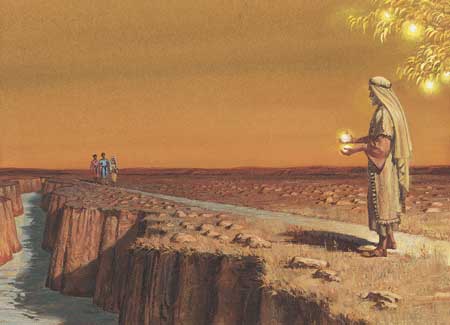Nephi tells us that his father, Lehi, kept a record (1 Nephi 1:17). That record is lost to history, but nonetheless his legacy lives on. His son recorded a number of his most profound prophecies and visions. These include his prophetic call vision, powerful poetic declarations to his two oldest sons while encamped in an Arabian wadi, his moving dream about the tree of life, and his prophecies about the Messiah.
Lehi’s legacy was solidified by the testament he left behind. While nearing his death, Lehi called together his posterity, warned them of temptations, taught them to live righteously, blessed them, and related prophecies (2 Nephi 1–4). Book of Mormon Central has dubbed this the “Testament of Lehi” because it has all the characteristics found in the Jewish testamentary literature. Book of Mormon Central also comments on the legacy this creates for Lehi:
It provides an example for fathers and patriarchs today. The tradition, initially but briefly present in Genesis 49, was not maintained and developed only by the Jews after their return to Jerusalem in the Second Temple period but was called upon extensively and effectively by Lehi in the sixth century BC. Building from there, later prophets in the Book of Mormon followed Lehi’s example, as Alma does in Alma 36–42 and Helaman does in Helaman 5:5–13. Latter-day Saint fathers today also follow these patriarchal examples as they bless, instruct, exhort, and testify to their children and grandchildren.
Some of Lehi’s most influential teachings were given as part of his testament. For instance, drawing on the imagery of the Psalms, Lehi taught about the importance of offering the Lord your broken heart and contrite spirit. Of this teaching, Book of Mormon Central pointed out, “This presents an important lesson for modern Book of Mormon readers. No matter what sacrifice we offer to the Lord—be it our time, our talents, etc.—if this is not done with the true sacrifice of our hearts and spirits, then it cannot be fully acceptable to the Lord.”
It is also as part of his testament that Lehi gave his epic discourse on the Fall. Drawing from the hints found in the Old Testament and Israelite temple traditions, Lehi provided the most complete teaching on the Fall presently on record. According to Book of Mormon Central,
Lehi’s teaching was the foundation for several other important sermons in the Book of Mormon by Alma, Amulek, and others, and continues to be the foundation upon which we build when we teach the Fall today.
Nephi’s love for Isaiah may have come from Lehi, since Lehi appears to be drawing on Isaiah 14:12 when he describes Satan. Isaiah 14 is drawing on a rich ancient Near Eastern mythos of a fallen deity, and like he does with the Fall, Lehi expands on Isaiah’s use to provide a fuller view of the Adversary. Indeed, Lehi seems well versed in the great literature of his day and time, as he poetically describes death in a way the resonates not only with the much later Shakespeare, but also with ancient Egyptian, Mesopotamian, Canaanite, and Israelite motifs.
Drawing on both the literary form and the language of the Psalms, Nephi lamented after his father passed away. Nephi, however, was not the only one of Lehi’s sons who was profoundly impacted by their father’s influence. In his first sermon recorded in the Book of Mormon, Jacob taught many of the same doctrines Lehi had taught to him. As Book of Mormon Central puts it,
Tracing Jacob’s understanding of the plan back one generation earlier, it appears that his inspired summation carried forth the influence of his father’s instructions to him in 2 Nephi 2. Although Lehi never called it a “plan,” he taught these same doctrines in his final blessing to Jacob.
Comparing the two also illuminates which doctrines both Lehi and Jacob most related to:
Though they taught the same doctrines, Lehi’s emphasis was focused more on the fall, opposition, and the agency afforded to all to choose between good and evil. Jacob, meanwhile, put more emphasis on the atonement, resurrection, and the eternal outcome from choosing either righteousness or filthiness.
Jacob also shows an awareness of Israelite and ancient Near Eastern conceptions of death. Given that Jacob was born in the wilderness and was still very young when the family arrived in the promised land, this knowledge surely came to him through his father’s teachings.
Given the reverence both Nephi and Jacob had for Lehi, it may seem odd that Nephi summoned Isaiah to act as a third witness of the Redeemer alongside Nephi and Jacob. Lehi had already born witness of Christ, multiple times (1 Nephi 1:19; 1 Nephi 10; 2 Nephi 2). Yet, this may actually be one of the most powerful reflections of Nephi’s love for his father.
Lehi was believed to be a false prophet by both the Jews at Jerusalem and also his two oldest sons, Laman and Lemuel. The penalty for false prophecy was death, and Laman and Lemuel try to kill him multiple times. Biblical law required two or three witnesses (Deuteronomy 19:15) to testify in a trail. As such, coming on the heels of Lehi’s passing, and the division of Nephi from his brothers, 2 Nephi 6–30, recording the testimonies of Nephi’s three witnesses—Jacob, Isaiah, and Nephi—could be read as the Apology of Lehi.
That is, it is Nephi’s defense of Lehi as a true prophet, marshalling the biblically required three witnesses to verify Lehi’s own prophecies about the Messiah. This would explain why Lehi himself was not considered one of the witnesses—he was the defendant. If this is correct, then it would speak powerfully to the legacy of Lehi, as nearly all of 2 Nephi would be dedicated to him in some capacity.
In either case, there is no denying the abundant legacy of Lehi left behind by his sons.


